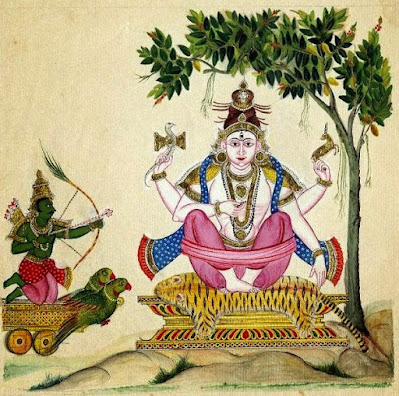Tripura Sundari stotram often considered as Tripura Sundari Ashtakam is one of the great hymns composed by Sri Adi Shankaracharya to praise the Goddess Tripura Sundari — the one among the Dasa Maha Vidyas, known for bestowing boons and fulfilling the wishes of her devotees.
I am posting this particular strotram because it celebrates the Goddess "who wanders in the forests of Kadamba trees" which is appropriate to the previous posting of "The Story of How Indra got rid of his sin," as the boon Indra requested of Lord Siva was to forever worship Him in the Kadamba Forest. This is truly a joyous, beautiful strotram.
 |
| Goddess Tripura Sundari |
Tripura Sundari Stotram Lyrics and Meaning
Kadamba vana charineem Muni kadamba kaadambineem
Nitamba jitha bhudaraam suranitambini seevitaam
Navamburuha lochana Abhinavaambudha Shyamalam
Trilochana Kutumbineem Tripura Sundari maasraye (1)
O Goddess Tripura Sundari, who wanders in the forests of Kadamba trees, who acts like a blissful cluster of clouds to the Muni’s filled with spiritual thirst.
Who conquered the mountains by her hips, O the one served by the celestial maidens of great attributes.
The one whose eyes resembles a lotus, who is looking like a newly formed cloud, the one in dark blue complexion
The consort of the three eyed God, O Goddess Tripura Sundari, I seek your refuge.
Kadamba vana vaasineem kanaka vallakii dharineem
Mahaarhamani haarineem mukha sammulla sadwaaruneem
Dayaavibhava kaarineem visada-rochanaa chaarineem
Trilochana Kutumbineem Tripura Sundari maasraye (2)
O Goddess Tripura Sundari, who lives in the Kadamba tree forests, who holds a golden veena
Who is adorned with the jewelry (haram’s) studded with gems of great value, whose face is shining with the ambrosia.
The compassionate one, who bestows the prosperity and the one with large eyes that indicates an enlarged look which pervades everywhere
The consort of the three eyed God, O Goddess Tripura Sundari, I seek your refuge.
Kadamba vana shaalaya kucha bharolla sanmaalaya
Kuchopamitha shailaya gurukrupala sadwelaya
Madaaruna kapolaya madhurageeta vaachaalaya
Kayaapi ghana neelaya kavachitha vayam leelaya (3)
O Goddess Tripura Sundari, who had made the Kadamba forests as her adobe, who is adored with garlands that are present around the bosom
Whose bosom resembles the mountains (indicating motherly nourishment), who at all the times bestows the grace
Whose cheeks are red and the one whose words are like sweet and delightful songs
The one whose body is like dark blue like clouds (indicating the bestowing nature), we are armoured by the grace of her play.
Kadamba vana madyagaam kanaka mandalopasthitham
Shadam bhuruha vaasineem satatasiddha saudamineem
Vidambita japa-ruchim vikacha-chandra chudaamanim
Trilochana Kutumbineem Tripura Sundari maasraye (4)
O Goddess Tripura Sundari, who lives in the middle of Kadamba forests, seated on the golden place
who lives in the six lotuses, Who is the constant lightening source for the wise to achieve the divine knowledge
Resembling the radiance of the fully blossomed Japa flowers (Hibiscus), who is adorned by the moon as her ornament on the forehead
The consort of the three eyed God, O Goddess Tripura Sundari, I seek your refuge.
Kuchanchitha vipanchikaam Kutila kuntalaa lamkrutaam
Kusaesaya nivaasineem Kutila chitta vidweshineem
Madaaruna vilochanaam manasijaari sammohineem
Matanga muni kanyakaam madhura bhashinee maasraye (5)
O the Goddess Tripura Sundari, the one who is with the vina that is present over the bosom, the one who is resplendent with the locks of hair
Who resides in the lotus (the lotus of Sahasrara chakra), who is against the wicked actions
Who eyes had turned red due to the Madhu, who delights the destroyer of the Manmadha (God Shiva) (Manasija is another name of Manmadha, which means one born from the mind of Brahma)
The daughter of Sage Matanga, The one who always has sweet conversations, I seek your refuge.
Smareth pradhama pushpineem rudhira-bindhu neelambaraam
Gruheetha madhu paatrikaam mada vighuurna netraamchalam
Ghana sthana bharoonnataam galitha chulikaam Shyamalaam
Trilochana Kutumbineem Tripura Sundari maasraye (6)
O Goddess Tripura Sundari, the one who holds the first flower arrow of the manmada, who has a red bindhu (kumkuma), who is adorned with blue garments
Holding the pot of ambrosia and the eyes filled with energy
Whose bosom is with great weight (indicating the nourishing nature of the mother of creation), who is with disheveled hair and in the completion of blue (indicating incarnation of Goddess Tara)
The consort of the three eyed God, O Goddess Tripura Sundari, I seek your refuge.
Sakumkuma vilepanaam alika chumbhi kasturikaam
Samanda hasithe kshanaam sashara chapa paasaamkusam
Ashesha jana mohinee aruna maalya bhushaambaraam
Japa Kusuma bhasuraam japavidhou smaram Ambikaam (7)
O Goddess Tripura Sundari, the one whose body is smeared with the pastes of Vermilion, whose forehead is applied with scents like Kasturi
Who looks after all the creatures displaying gentle smile and pleasant eyes, who is adorned with arrows, bow, noose and a goad in her hands.
The one who can enchant all the creatures, bedecked with the red garlands, jewels, and garments
The one looks enchanted with the hibiscus flowers, I sit to do japa and meditate on you, O Goddess Ambika.
Purandhara purandrikaam chikura-bhandha sairandrikaam
Pitaamaha pativrataam patu pateera charcharataam
Mukunda ramanii mani lasa dalamkriyaa kaarineem
Bhajami bhuvanaambikaam sura vadhutikaa chetikaam (8)
O Goddess Tripura Sundari, who has Indrani, the spouse of Indra (Purandhara purandhrika – Wife of Lord of Puras – Indra) to set her braids of hair
Who has the wife of Brahma – Saraswati to applying the pastes of sandalwood
O the one who has the women of Vishnu (Mukunda) engaged adorning the ornaments and gems
I worship you the Bhuvana-Ambika (the great Goddess of the worlds), the one served by the celestials as her attendants.





























